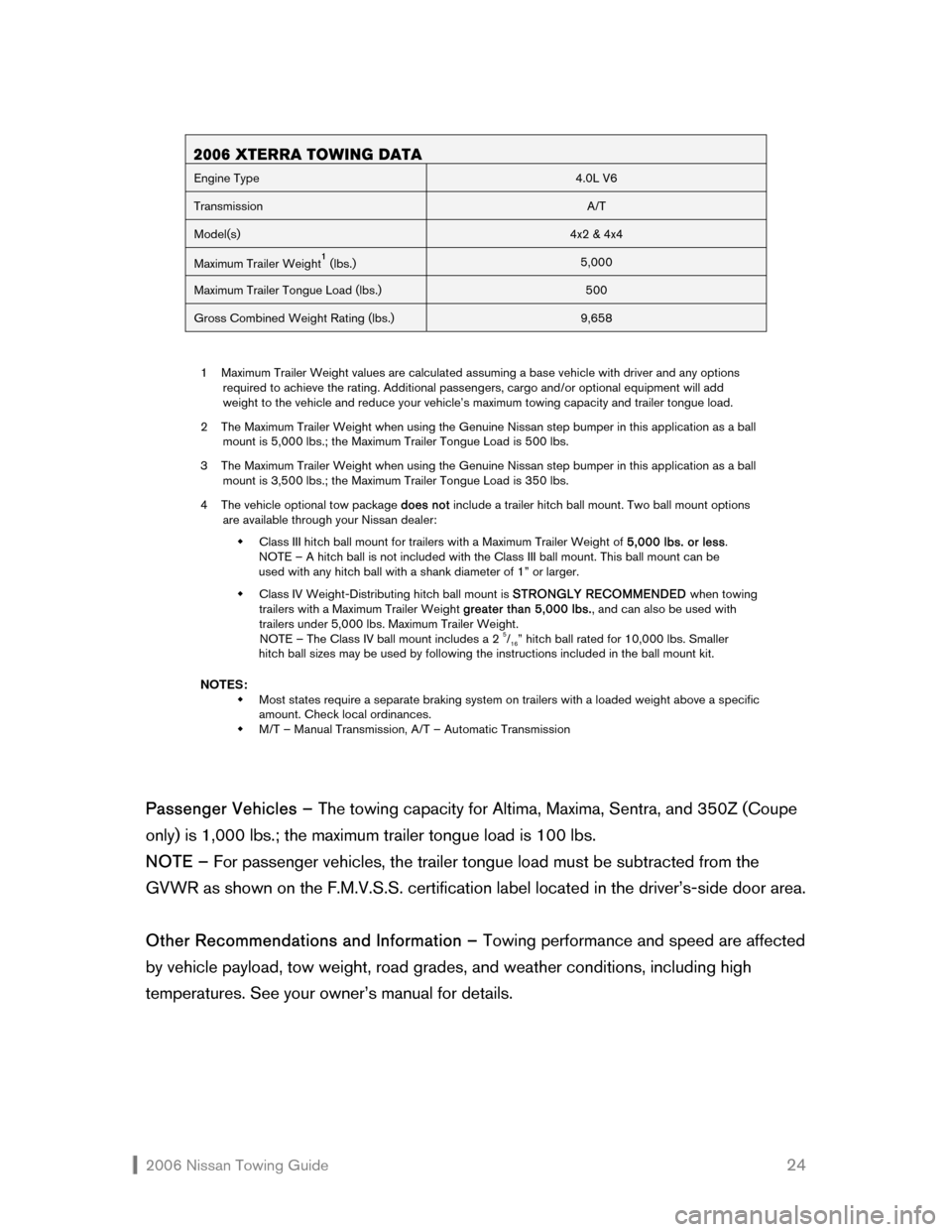2006 NISSAN ALTIMA load capacity
[x] Cancel search: load capacityPage 2 of 28

2006 Nissan Towing Guide 1
INTRODUCTION
SAFETY IS PRIORITY ONE
Obviously, your first concern should be safety. Your vehicle was designed to be used
primarily to carry passengers and cargo. Always remember that towing a trailer places
additional loads on your vehicle’s engine, drivetrain, steering, braking, and other systems.
Therefore, be certain that your vehicle can meet the demands of the towing application you
have in mind.
Rent or purchase only the highest-quality towing and safety equipment you can find.
Reinforced tow hitches designed especially for certain Nissan vehicles are available from
your Nissan dealer.* Hitches for the other Nissan models should be bought from and
installed by a professional supplier of towing equipment. Finally, it is important to follow the
towing capacity limit set for your specific vehicle, and to ensure that your vehicle is in top
mechanical condition; especially the tires, brakes, suspension, and engine cooling system.
See your owner’s manual for details.
NEVER EXCEED THE ESTABLISHED TOWING CAPACITY
Towing capacities vary from vehicle to vehicle. See the SPECIFICATIONS section of this
guide to view the towing capacities of 2006 Nissan vehicles produced at the time of
Towing Guide publication. Use this data to help select the proper Nissan vehicle to meet
your anticipated needs, and refer to it when renting a trailer or other piece of towing
equipment.
EQUIP YOUR NISSAN FOR TOWING
The frequency and type of towing should also influence the manner in which you equip
your vehicle. If you plan to tow often, either for recreation or work, select the engine size,
transmission type, suspension, and towing capacity that are best suited to your
requirements. This guide can help you select that equipment.
If, on the other hand, your towing will be infrequent, choose the Nissan vehicle and
equipment that best meets your day-to-day needs. Then, be careful not to exceed the
towing capacity on those few occasions when you do tow.
READ THIS GUIDE BEFORE YOU TOW
This guide was designed to provide an overview of safe towing practices. In it you’ll find
information on towing equipment, safety, proper loading and driving techniques, towing tips,
and much more.
It is also a good idea to discuss your towing requirements with either your Nissan dealer
or a professional supplier of towing equipment before you equip your Nissan vehicle for
towing. Finally, there are state and local laws on towing that you should review to ensure
you comply with all regulations.
*Quest tow hitch is factory installed only.
Page 15 of 28

2006 Nissan Towing Guide 14 TIRE PRESSURE
When towing a trailer, increase tow vehicle tire pressures to the recommended cold
specifications. You’ll find these figures in the owner’s manual and on the tire pressure chart
located in the vehicle. Trailer tire condition, size, load rating, and inflation pressure should
be in accordance with the trailer and tire manufacturer’s specifications.
TOWING
SAFETY
Towing can dramatically alter the handling and performance characteristics of your vehicle.
Plus, it puts increased strain on the engine and drivetrain. Therefore, it is always a good
idea to approach towing from the standpoint of safety — whether you’re purchasing
equipment or actually pulling the trailer.
Always make sure your vehicle’s towing capacity is adequate for the trailer you intend to
tow. Buy or lease only quality equipment, and have it installed only by professionals.
In addition, be certain that you have all of the equipment needed for safe towing,
including safety chains/cables, electric trailer brakes, electric trailer brake controller,
breakaway switch, extended rear view mirrors, and so on. All of these items have been
discussed in a previous section of this guide.
With regard to vehicle maintenance, you should follow a more frequent schedule, and
check fluid levels, pressures, tire condition, etc., more often when on the road. See your
owner’s manual for details.
LOADING YOUR TRAILER
Taking the time to load and balance your trailer properly will improve overall handling and
minimize the strain on your tow vehicle. Incorrectly loaded trailers tend to sway or swing
from side to side, upsetting vehicle handling. Careful loading and balancing can help
eliminate these problems.
As mentioned earlier, conventional trailer tongue load should fall between 10-15% of
the total trailer weight, and king pin load — if using a 5th wheel or gooseneck trailer —
should be between 15-25% of the total trailer weight. Excessive tongue/king pin load can
actually push the vehicle down in back, lifting the front wheels to a point where traction,
steering response, and braking are severely reduced. Insufficient tongue/king pin load can
cause instability, which may lead to “tail wagging” or jackknifing.
Page 16 of 28

2006 Nissan Towing Guide 15 With this in mind, proper loading is
extremely important. When loading a trailer,
60% of the total cargo weight should be
positioned in the front portion of the trailer
and 40% in the back. Then, the load should
be adjusted until the proper tongue/king pin
load ratio is achieved.
The trailer load should be balanced
equally from side-to-side. Unequal side-to-
side loading can negatively affect handling
and braking. Once in place, all cargo should
be firmly secured to prevent shifting. If the
load should shift abruptly during braking or
cornering, it could quickly affect the
handling of your vehicle and cause a very
unsafe situation.
Finally, do not carry flammable materials,
such as gasoline, in your trailer. In the event
of an accident, an explosion or fire could
occur.
ENSURING VEHICLE/TRAILER STABILITY
Improper loading, excessive or insufficient trailer tongue/king pin load, overloading,
excessive trailer weight, poorly designed trailer suspensions, crosswinds, and poor
maintenance are all things that can affect the stability of your vehicle/trailer combination.
If swaying does occur, check the cargo load for proper balance and distribution to
ensure proper trailer tongue/king pin load. In addition, check the condition of the
suspension and shocks, as well as the tires, tire pressures, and wheel bearings on both the
tow vehicle and the trailer. If swaying occurs because of high winds or poor weather
conditions, wait until these conditions improve before resuming your trip.
If the swaying continues and you feel your trailer is suitably balanced and within the
towing capacity limits of your vehicle, discontinue towing and consult your Nissan dealer or
trailer manufacturer to determine the problem. Most important, do not tow until the problem
is corrected.
Page 22 of 28

2006 Nissan Towing Guide 21
TOWING
GLOSSARY
5TH WHEEL
HITCH Located just forward of the rear axle centerline, this hitch uses a king pin to serve
as the pivot point for the trailer.
BALL MOUNT A bar that holds the hitch ball and is inserted into the hitch receiver. Also
commonly called a drawbar or “stinger.”
BREAKAWAY SWITCH A safety device using a trailer battery that automatically applies the trailer’s
brakes if it should accidentally become separated from the tow vehicle. A
breakaway switch may be used with both electric or surge trailer brake systems.
BUMPER HITCH A reinforced bumper designed to accommodate a hitch ball.
ELECTRIC TRAILER
BRAKES When the brakes on a tow vehicle are applied, an electric current is sent to an
actuator which applies the trailer’s brakes.
ELECTRIC TRAILER
BRAKE CONTROLLER A device that controls the electric trailer brakes.
GOOSENECK HITCH Located just forward of the rear axle centerline, this hitch uses a ball to serve as
the pivot point for the trailer.
GROSS AXLE
WEIGHT RATING (GAWR) The maximum amount of weight each vehicle axle (front and rear) is designed to
safely carry.
GROSS COMBINED
WEIGHT RATING (GCWR) The maximum allowable combined weight of the vehicle and trailer, including
passengers and all cargo.
GROSS VEHICLE
WEIGHT RATING (GVWR) The maximum allowable weight of the vehicle, including passengers, cargo, fuel,
hitch, trailer tongue load, and any optional equipment.
KING PIN
LOAD The amount of trailer (5th wheel or gooseneck) weight pressing down on the tow
vehicle hitch.
HITCH BALL
A ball that connects the trailer to the tow vehicle hitch and provides the means
by which the trailer pivots during cornering. Available in a number of sizes and
weight capacities, it must correspond to the trailer coupler size, and have a
sufficient capacity rating for the trailer being pulled.
RECEIVER HITCH A frame- or structure-mounted hitch with a receiver that allows removal of the
ball mount.
SAFETY CHAINS/CABLES Provides an emergency connection between the tow vehicle and the trailer,
should the trailer become disengaged for any reason.
SURGE BRAKES
Hydraulic-type braking system activated by inertia. As the tow vehicle begins to
brake, the trailer pushes against the hitch ball, consequently activating the trailer
brakes.
TRAILER TONGUE/COUPLER The part of the trailer that extends forward to meet the tow vehicle, and also
carries the coupler assembly.
TRAILER TONGUE
LOAD The amount of trailer (conventional) weight pressing down on the tow vehicle
hitch.
WEIGHT-DISTRIBUTING HITCH
SYSTEM Type of hitch system that helps shift the trailer tongue weight to all trailer tires
and the tow vehicle front tires. Strongly recommended when towing trailers with
a Maximum Trailer Weight greater than 5,000 lbs.
WIRING HARNESS
Provides an electrical connection linking the tow vehicle’s electrical system to
the trailer’s system.
Page 25 of 28

2006 Nissan Towing Guide 24
Passenger Vehicles – The towing capacity for Altima, Maxima, Sentra, and 350Z (Coupe
only) is 1,000 lbs.; the maximum trailer tongue load is 100 lbs.
NOTE – For passenger vehicles, the trailer tongue load must be subtracted from the
GVWR as shown on the F.M.V.S.S. certification label located in the driver’s-side door area.
Other Recommendations and Information – Towing performance and speed are affected
by vehicle payload, tow weight, road grades, and weather conditions, including high
temperatures. See your owner’s manual for details.
2006 XTERRA TOWING DATA
Engine Type 4.0L V6
Transmission A/T
Model(s) 4x2 & 4x4
Maximum Trailer Weight1 (lbs.) 5,000
Maximum Trailer Tongue Load (lbs.) 500
Gross Combined Weight Rating (lbs.) 9,658
1 Maximum Trailer Weight values are calculated assuming a base vehicle with driver and any options
required to achieve the rating. Additional passengers, cargo and/or optional equipment will add
weight to the vehicle and reduce your vehicle’s maximum towing capacity and trailer tongue load.
2 The Maximum Trailer Weight when using the Genuine Nissan step bumper in this application as a ball
mount is 5,000 lbs.; the Maximum Trailer Tongue Load is 500 lbs.
3 The Maximum Trailer Weight when using the Genuine Nissan step bumper in this application as a ball
mount is 3,500 lbs.; the Maximum Trailer Tongue Load is 350 lbs.
4 The vehicle optional tow package does not include a trailer hitch ball mount. Two ball mount options
are available through your Nissan dealer:
�Š Class III hitch ball mount for trailers with a Maximum Trailer Weight of 5,000 lbs. or less.
NOTE – A hitch ball is not included with the Class III ball mount. This ball mount can be
used with any hitch ball with a shank diameter of 1” or larger.
�Š Class IV Weight-Distributing hitch ball mount is STRONGLY RECOMMENDED when towing
trailers with a Maximum Trailer Weight greater than 5,000 lbs., and can also be used with
trailers under 5,000 lbs. Maximum Trailer Weight.
NOTE – The Class IV ball mount includes a 2 5/16” hitch ball rated for 10,000 lbs. Smaller
hitch ball sizes may be used by following the instructions included in the ball mount kit.
NOTES:
�Š Most states require a separate braking system on trailers with a loaded weight above a specific
amount. Check local ordinances.
�Š M/T – Manual Transmission, A/T – Automatic Transmission